Welcome to the two-seat Sherwood Scout. We previously presented Sherwood’s single-place Kub. Now, our favorite British writer, Dave Unwin — master pilot of many aircraft of widely varying types — reviews the UK company’s Scout model. All photos are by UK photographer extraordinaire, Keith Wilson. Thanks to both gentlemen. Enjoy! —DJ
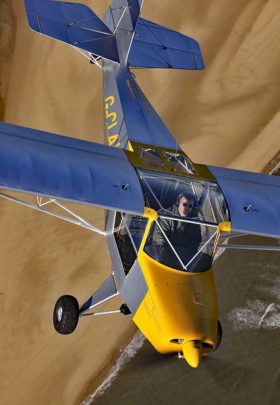 A handsome high-wing, side-by-side two seater, Scout’s lineage goes back to 1983, when Dean Wilson’s trendsetter-to-be Avid Flyer was first introduced.
A handsome high-wing, side-by-side two seater, Scout’s lineage goes back to 1983, when Dean Wilson’s trendsetter-to-be Avid Flyer was first introduced.
His often-imitated design was the basis for Kitfox, Rocky Mountain’s Ridge Runner and the Flying K Sky Raider. The latter morphed into the Just Aircraft Escapade.
When The Light Aircraft Company — TLAC — bought the design in 2013 the first thing Paul Hendry-Smith and his team did was implement a significant number of improvements to both its design and construction.
They improved stability, pitch authority, and decreased adverse yaw. After a year of flight testing various revisions, they enlarged both the elevator and rudder, cleaned up the junction between the wing root and flaps, added gap seals and implemented several other aerodynamic tweaks.
Describing Scout
Renamed the Sherwood Scout, TLAC currently market it as either a ready-to-fly factory-built microlight or as a kit or fast-build kit. The overall construction is TIG-welded 4130 steel tube, while the wings use aluminum spars and plywood ribs. The fuselage, wings and tail are all covered with Oratex (see at end) and power can be supplied by either the 80 or 100-horsepower Rotax 912, 85-horsepower Jabiru 2200, 95-horsepower UL260i or a 95-horsepower D-Motor. Scout can be configured with either a tricycle or tailwheel undercarriage (converting takes only two hours) and is fitted with wings that can be quickly and easily folded aft with no control disconnection.
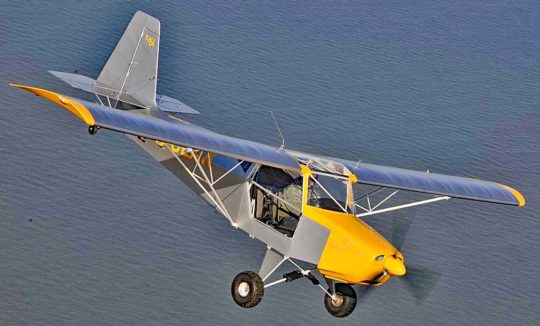 Of course, the folding mechanism adds both weight and complexity (two things that light aircraft designers generally try to avoid), but the trade-off in this instance is worth it; the wing-fold mechanism does not add much weight or complexity.
Of course, the folding mechanism adds both weight and complexity (two things that light aircraft designers generally try to avoid), but the trade-off in this instance is worth it; the wing-fold mechanism does not add much weight or complexity.
Scout’s constant chord wings are braced by V-struts, with about half of the trailing edge taken up by the large, single-slotted mechanically-actuated flaps with four positions: 0°–10°–25°–40°. Ailerons extend to the cambered tips, which feature large LED position lights.
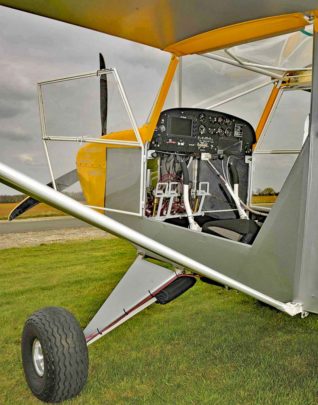 The tail consists of a very slightly swept-back fin and large rudder, a tailplane braced by a combination of struts and wires, and separate elevators. Primary controls are actuated by a mixture of pushrods, bellcranks, and cables. Longitudinal trim is provided by a large tab set into the trailing edge of the left elevator.
The tail consists of a very slightly swept-back fin and large rudder, a tailplane braced by a combination of struts and wires, and separate elevators. Primary controls are actuated by a mixture of pushrods, bellcranks, and cables. Longitudinal trim is provided by a large tab set into the trailing edge of the left elevator.
The main undercarriage uses bungees for shock absorption and is fitted with tundra tires and slotted hydraulic disc brakes. The pneumatic tailwheel steers through the rudder pedals up to about 30° each way; beyond that it breaks out and free-castors. If fitted with a nosewheel it free-castors with steering provided by differential braking.
All Scout’s fuel is carried in two 9-gallon metal tanks located in the wings, which feed into a fuselage-mounted one gallon header tank to give a total capacity of 20 gallons although a pair of 13-gallon long-range tanks are an option.
Access to the cockpit is good. The front-hinged doors are enormous — they open 180° — and the surrounding frame is comfortably low. The doors are skinned with Perspex, and the top half hinges upward. If it’s warm you can fly with the top half open, or simply remove the entire door!
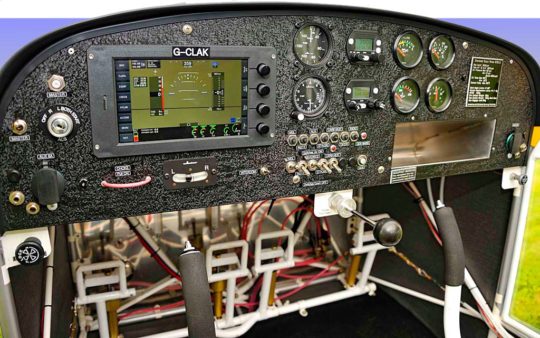
In another indicator of the high build spec there are toe brakes for both pilots. The tall, slightly curved sticks feel very natural, while levers for the flaps and trim are between the seats. The plunger-type throttle is mounted centrally just below the instrument panel, an easy reach from either seat.
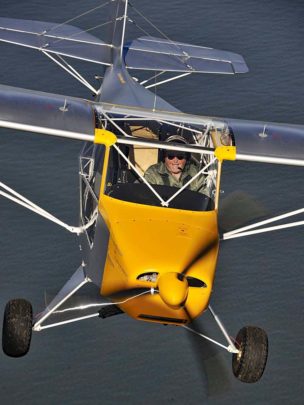
It’s all neatly and logically laid out, with very little to criticize. With the flaps deployed the trim lever isn’t quite so accessible while as fuel quantity remaining is only shown by sight-tubes in the wing roots.
The 912 starts easily (it is fitted with the “soft start system”) and runs smoothly, but I am soon reminded of what may be the worst feature of any 9-series Rotax: the powerful throttle springs. These are arranged to give full power should the throttle cable break, so unless you have the throttle friction wound right down, then the second you let go of the throttle that’s what happens. Of course, like most of us I generally keep my hand on the throttle when I’m on the ground, but even briefly setting the flaps, adjusting the trim, or any other task, can have the engine accelerating alarmingly quickly. Conversely, if the friction is wound right down, you have no finesse.
Preparing to Fly
With the minimal pre-take off checks complete and 25° of flap set I line up on runway 25 and smoothly open the throttle. I wouldn’t describe Keith and I as “overweight” — more “underheight” — but even with full tanks we’re still about 45 pounds below the 1,098-pound maximum all-up weight.
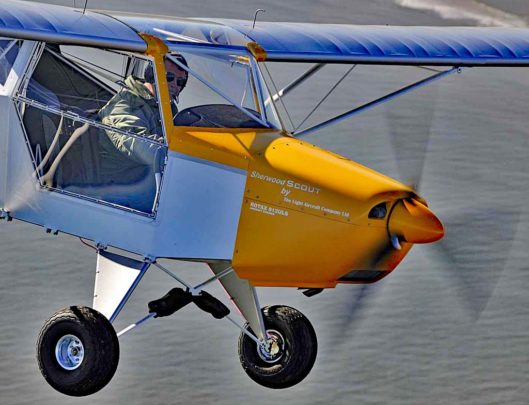
Aloft, I commenced my evaluation with an examination of the general handling, and a couple of steep turns and reversals reveal crisp, authoritative controls with delightfully pleasant stick forces. Controls all seemed agreeably light and reasonably frictionless, with low breakout forces and control around all three axes is very good, with the roll rate being particularly noteworthy. It’s fun to fly.
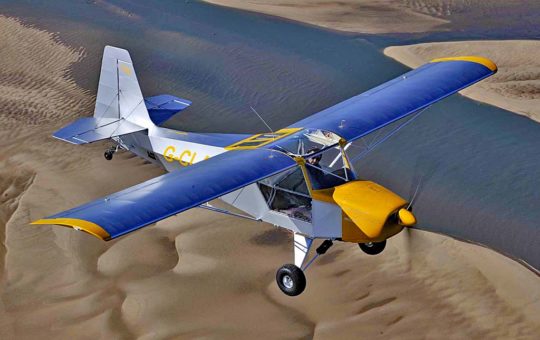
As the flaps extend they produce a very slight nose-down pitching moment that is easily trimmed out. There is no stall warning but the speeds are so slow and the deck angle so high that it’s obvious that something isn’t going well. With any flap deployed and irrespective of the power setting it always broke straight ahead, although with the flaps fully up it did have a slight tendency to drop the left wing. With full flaps and a hint of power we got the IAS down to 31 knots.
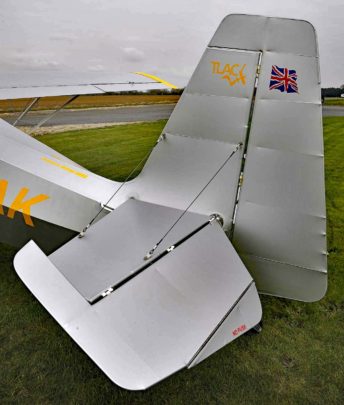
With Keith diligently taking notes, an examination of the cruise revealed that 5,100 rpm at 3,000 feet produced a TAS of 96 knots with a fuel flow of a bit more than four gph. This means that the range at fast cruise is around 360 nm with at least 30 minutes’ fuel left. Pulling the power down to 4,000 rpm saw the fuel flow drop to a bit over two gph. Fit the optional long range tanks and the maximum endurance rises to a butt-bruising eleven hours!
Back at launch airfield I discovered that, as with just about every other aspect of flying the Scout, it’s a very honest aircraft in the pattern, with perhaps the single caveat that pilots converting to it from older, heavier machines need to bear in mind that it has considerably less inertia than a Cessna 152 or Piper Tomahawk. Indeed, for the first few hours it’s probably prudent to stay away from using full flaps because speed bleeds away quickly. Maintain speed at 50 knots over the fence and Scout will touch down where you want it every time. Having got comfortable landing on the long runway 25 I finish off with a smooth three-pointer on the shorter length of turf that parallels the taxiway. Great fun!
One more thing: Folding Scout’s wings is both a quick and simple process while all the controls remain connected. That’s great for those who want to use less hangar space or wish to trailer their Scout.
Conclusions?
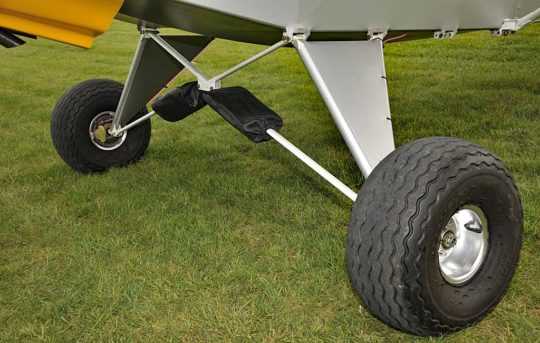
Sherwood Scout
The Light Aeroplane Company Ltd
- Length — 19 feet
- Height — 5.75 feet
- Wing Span — 28.5 feet / wings folded — 8 feet
- Wing Area — 120 square feet
- Empty Weight — 578 pounds
- Gross Weight — 1,098 pounds
- Useful Load — 522 pounds
- Payload (with full standard fuel) — 402 pounds
- Wing Loading — 10.47 pounds per square foot
- Power Loading — 11 pounds per horsepower
- Fuel Capacity — 20 gallons
- Baggage Capacity — 77 pounds
- Never-Exceed Speed — 115 knots
- Maximum Cruise (True Air Speed) — 95 knots
- Economical Cruise — 80 knots
- Stall — 34 knots
- Climb Rate — 1000 feet per minute
- Take Off Distance over 50 foot obstacle — 600 feet
- Landing Roll over 50 foot obstacle — 600 feet
- Powerplant — Rotax 912ULS 100hp
- Propeller — Composite three-blade fixed pitch
Oratex No-Paint Covering
Developed in Germany, Oratex is a water-based, solvent-free, pre-colored aircraft covering system that is available in two different weights, depending on the size of aircraft.
It is claimed to offer several significant advantages over legacy covering products such as Ceconite, Diatex, and Polyfiber. Unlike earlier systems, it is non-toxic and, being pre-colored, makes Oratex quicker and safer to work with, while the covered aircraft is invariably lighter, as you don’t have to paint it.


Would anyone know where it’s possible to find the scale drawings of the Sherwood scout, I have a project on this plane.
Dd you try the company? Links are provided in the article.
Ugh. YAAFSO (Yet another Avid Flyer spin-off). Yep, we literally need an acronym label at this point. LOL. I sure hope Dean Wilson gets ALL the credit for all of these things! Glad you mentioned him.
So the only real question anyone has is, how does it compare to a Kitfox? So far, not stoked about the limited useful load, same reason I’m not stoked about the Avid (most of em anyway). Would be curious about the handling and noise, etc, versus Kitfox, or Just, or… I think I’ll stop there. 🙂
I fly the Sherwood Scout but have a good many hours in the Kitfox 3 & 4, and to me the Scout is definitely preferable. The wingfold on the Kitfox is quite tricky and needs to be handled with care. The loadspace in the Scout is invaluable, and there’s more or less nothing in the Kitfox. The Scout is stable in yaw, which the Kitfox isn’t and the Scout can handle 80-100hp, while the Kitfox doesn’t really. I’ve no experience of later Kitfoxes, but they don’t fit the UK market regulations too well. For the UK market, the Scout is a huge improvement.
I built the STOL and Speedwing versions (wings) for my Avid Flyer……it’s great to see Dean Wilson’s design continue.
One feature you mention, but don’t push strongly enough is the folding wing capability. With the wings vertically laid back alongside the fuselage its VERY trailerable and legally within the USA trailer width on the highways, even with enclosed trailer setups. Plus, there is no airfoil effect at speed on the highway., if transporting on an open trailer.
I do hope this company advertises in the U.S. and is successful in promoting this little airplane …having those engine options will make it very desirable.
Sid Hausding, Alpena, Mi 49707
1936 design and technology, for the pleasure and satisfaction of those who love the status quo, and ignore any change and risk.
Example: the Navy installed AOAs on every carrier-based aircraft starting in 1956; and the FAA has impeded simple installation as proposed to Najeeb Hallaby in 1961, and still does. It still teaches stall SPEED instead of stall ANGLE.
The FAA refuses to allow “minor changes” which are allowed by law, to be used in practice, and requires 3378s… etc., etc., etc.